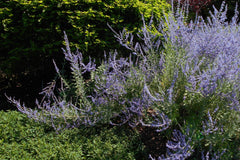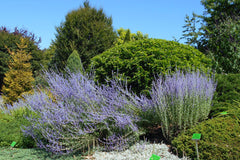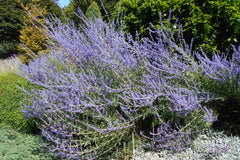







About this cultivar:
Salvia 'Little Spire' (Pe) is an compact, erect, small deciduous sub-shrub to, with white stems bearing deeply-divided, aromatic greyish leaves. Small violet-blue flowers in large plumy panicles in late summer and autumn.
It used to be placed in the genus Perovskia (after Russian general V. A. Perovski 1794 - 1857), commonly called Russian Sage, which is now seen as a species or group under Salvia. This group has been identified by the RHS as a plant which is 'Perfect for Pollinators'.
Smaller than most Russian sage, this one was selected in Holland in 1995 by Herbert Oudshoorn, perfect for smaller gardens, maybe even as a small 'hedge' if kept trimmed back.
- Position: Full sun, partial shade (much better in full sun though)
- Soil: Almost any soil, dry soil, grows well in DRY AREAS of Ballyrobert
- Flowers: July, August, September, October
-
Other features: Grows well in Ballyrobert, Bees and Butterflies
- Hardiness: H5 - Hardy in most places throughout the UK even in severe winters (-15 to -10°C), Fully hardy - grows well in Ballyrobert!
- Habit: Bushy, Clump forming
- Foliage: Deciduous
- Height: 50 - 75 cm (1.5 - 2.5 ft)
- Spread: 60 - 100 cm (2 - 3 ft)
- Time to full growth: 2 to 5 years
- Plant type: Herbaceous Perennial, Shrub
- Colour: Purple, green, blue
-
Goes well with: Grasses, Stipa, Cotinus, Sedum, Eucomis, Actaea. Dark foliage plants.
About this genus:
Salvia is the largest genus of plants in the family Lamiaceae (mint, deadnettle, or sage family) distributed throughout the northern hemisphere and the Americas, with three distinct regions of diversity: South America, Central Asia and the Mediterranean, and Eastern Asia.
Containing many species of shrubs, sub shrubs, herbaceous perennials, biennials, and annuals the genus has undergone constant revision since many species are similar to each other. There have been as many as two thousand named species and subspecies. Over time, this number has been reduced by botanists to less than a thousand.
The common name, Sage, is derived from the Middle English sawge, which was borrowed from the Old French sauge, which came from the from the Latin salvus, related to salvere (meaning ‘to heal’), which is the source of the botanical name, Salvia. Pliny the Elder was the first author known to describe a plant called ‘Salvia’ by the Romans, likely describing Salvia officinalis.
The stems are typically angled like other members in Lamiaceae. The leaves are typically entire, but sometimes toothed or pinnately divided. In some species the bracts on the flowering stems are ornamental and showy. The flowers are produced in racemes or panicles, and generally produce a showy display with flower colours ranging from blue to red, with white and yellow less common.
Most garden Salvia have hairs (trichomes) growing on the leaves, stems and flowers. These hairs help to reduce water loss in some species but they also secrete oils that typically give a distinctly lovely aroma to the plant, especially when these parts are crushed.
Ok, growing conditions? The ‘large genus so we have to be vague’ disclaimer does apply a bit, so, sorry. But if you have to pin us down, we don’t grow a lot of salvia in our garden. We find they don’t overwinter well with us, possibly because of the winter wet and not the winter cold. However, the few Salvia that we offer for sale are pretty good and do well for us, albeit in the dryer parts of the garden. These selections are worth trying because of the wonderful smell, prolific flowers, long flowering period, and seed head structure.
Try growing the light-leaved-types against dark foliaged plants like Cotinus, Sedum, Eucomis, Actaea, and so on. The larger types also look great with grasses such as Stipa. Most folk like to put them near the front of the border or path so they can reach out, crush a few leaves, and take in the scent. It helps that these areas are often dryer areas too.

